Rangeland Management and Ecological Adaptation Analysis Model for Astragalus curvirostris Boiss
Abstract
1. Introduction
2. Materials and Methods
2.1. Geographic Position and Characteristics of the Studied Area
2.2. Habitat Characteristics of the Studied Area
2.3. Methodology
2.4. Data Collection of the Environmental Factors in the Distribution Location of the Studied Species
2.5. Determining the Growth Stages of the Studied Species
2.6. Data Analysis
2.7. Constructing the Response Curve of the Studied Plant Species to Environmental Factors
3. Results
3.1. Identified Plant Species
3.2. Vegetation Characteristics of the Studied Region
3.3. Investigating the Ecological Requirements of A. curvirostris in the Studied Habitat
3.4. Growth Stages of A. curvirostris in Zanjan Province
4. Discussion
Author Contributions
Funding
Institutional Review Board Statement
Informed Consent Statement
Data Availability Statement
Conflicts of Interest
References
- Austin, M.P. Spatial prediction of species distribution: An interface between ecological theory and statistical modelling. Ecol. Model. 2002, 157, 101–118. [Google Scholar] [CrossRef]
- Austin, M.P.; Smith, T.M. A new model for the continuum concept. Vegetatio 1989, 83, 35–47. [Google Scholar] [CrossRef]
- Ter Braak, C.J.F. The analysis of vegetation-environment relationships by canonical correspondence analysis. Vegetatio 1987, 69, 69–77. [Google Scholar] [CrossRef]
- McGill, B.J.; Enquist, B.J.; Weiher, E.; Westoby, M. Rebuilding community ecology from functional traits. Trends Ecol. Evol. 2006, 21, 178–185. [Google Scholar] [CrossRef] [PubMed]
- Pearson, R.G.; Dawson, T.P. Predicting the impacts of climate change on the distribution of species: Are bioclimate envelope models useful? Glob. Ecol. Biogeogr. 2003, 12, 361–371. [Google Scholar] [CrossRef]
- Guisan, A.; Theurillat, J.-P.; Kienast, F. Predicting the potential distribution of plant species in an alpine environment. J. Veg. Sci. 1998, 9, 65–74. [Google Scholar] [CrossRef]
- Guisan, A.; Weiss, S.B.; Weiss, A.D. GLM versus CCA spatial modeling of plant species distribution. Plant Ecol. 1999, 143, 107–122. [Google Scholar] [CrossRef]
- Peterson, A.T. Predicting Species’ Geographic Distributions Based on Ecological Niche Modeling. Condor 2001, 103, 599. [Google Scholar] [CrossRef]
- Bakkenes, M.; Alkemade, J.R.M.; Ihle, F.; Leemans, R.; Latour, J.B. Assessing effects of forecasted climate change on the diversity and distribution of European higher plants for 2050. Glob. Chang. Biol. 2002, 8, 390–407. [Google Scholar] [CrossRef]
- Moisen, G.G.; Frescino, T.S. Comparing five modelling techniques for predicting forest characteristics. Ecol. Model. 2002, 157, 209–225. [Google Scholar] [CrossRef]
- Guisan, A.; Zimmermann, N.E. Predictive habitat distribution models in ecology. Ecol. Model. 2000, 135, 147–186. [Google Scholar] [CrossRef]
- Guisan, A.; Edwards, T.C.; Hastie, T. Generalized linear and generalized additive models in studies of species distributions: Setting the scene. Ecol. Model. 2002, 157, 89–100. [Google Scholar] [CrossRef]
- Berg, Å.; Gärdenfors, U.; von Proschwitz, T. Logistic regression models for predicting occurrence of terrestrial molluscs in southern Sweden—Importance of environmental data quality and model complexity. Ecography 2004, 27, 83–93. [Google Scholar] [CrossRef]
- Engler, R.; Guisan, A.; Rechsteiner, L. An improved approach for predicting the distribution of rare and endangered species from occurrence and pseudo-absence data. J. Appl. Ecol. 2004, 41, 263–274. [Google Scholar] [CrossRef]
- Robertson, M.P.; Peter, C.I.; Villet, M.H.; Ripley, B.S. Comparing models for predicting species’ potential distributions: A case study using correlative and mechanistic predictive modelling techniques. Ecol. Model. 2003, 164, 153–167. [Google Scholar] [CrossRef]
- Austin, M.P.; Belbin, L.; Meyers, J.A.; Doherty, M.D.; Luoto, M. Evaluation of statistical models used for predicting plant species distributions: Role of artificial data and theory. Ecol. Model. 2006, 199, 197–216. [Google Scholar] [CrossRef]
- Abbasian, H.; Kiabi, B.H.; Kavousi, K. Food habits of Wild Goat, Capra aegagrus aegagrus, in the Khorramdasht area, Kelardasht, Iran. Zool. Middle East 2004, 33, 119–124. [Google Scholar] [CrossRef]
- Alavi, J.; Nouri, Z.; Zahedi, A.G. The Response Curve of Beech Tree (Fagus Orientalis Lipsky.) in Relation to Environmental Variables Using Generalized Additive Model in Khayroud Forest, Nowshahr. Wood For. Sci. Technol. Res. 2017, 24, 29–42. [Google Scholar] [CrossRef]
- Assadi, M.; Maassoumi, A.A.; Jamzad, Z. Flora of Iran; Research Institute of Forests and Rangelands: Isfahan, Iran, 2007; p. 24S. [Google Scholar]
- Modarres, R.; Sarhadi, A. Rainfall trends analysis of Iran in the last half of the twentieth century. J. Geophys. Res. 2009, 114. [Google Scholar] [CrossRef]
- Rechinger, K.H. Flora Iranica: Flora des Iranischen Hochlandes und der Umrahmenden Gebirge: Persien, Afghanistan, Teile von West-Pakistan, Nord-Iraq, Azerbaidjan, Turkmenistan; Akademische Druck-u. Verlagsanstalt: Graz, Austria, 1990. [Google Scholar]
- Davis, P.H.; Cullen, J.; Coode, M.J.E.; Mill, R.R.; Tan, K.; Guner, A. Flora of Turkey and the East Aegean Islands; University Press: Edinburgh, Scotland, 1965. [Google Scholar]
- Noedoost, F.; Riahi, H.; Sheidai, M.; Ahmadi, A. Distribution of Charophytes from Iran with Three New Records of Characeae (Charales, Chlorophyta). Cryptogam. Algol. 2015, 36, 389–405. [Google Scholar] [CrossRef]
- Kuehl, R.O.; Breckenridge, R.P.; Panda, M. Integrated response plot designs for indicators of desertification. Environ. Monit. Assess. 1995, 37, 189–209. [Google Scholar] [CrossRef] [PubMed]
- Cain, S.A.; Castro, G.D. Manual of Vegetation Analysis; Harper: New York, NY, USA, 1959. [Google Scholar]
- Eichenberger, J.K.; Parker, G.R.; Beers, T.W. A Method for Ecological Forest Sampling. Indiana AES Res. Bull. 1982, 969, 3–9. [Google Scholar]
- Kouba, Y.; Merdas, S.; Mostephaoui, T.; Saadali, B.; Chenchouni, H. Plant community composition and structure under short-term grazing exclusion in steppic arid rangelands. Ecol. Indic. 2021, 120, 106910. [Google Scholar] [CrossRef]
- Traoré, S.; Zerbo, L.; Schmidt, M.; Thiombiano, L. Acacia communities and species responses to soil and climate gradients in the Sudano-Sahelian zone of West Africa. J. Arid Environ. 2012, 87, 144–152. [Google Scholar] [CrossRef]
- Palmer, M.W. Putting Things in Even Better Order: The Advantages of Canonical Correspondence Analysis. Ecology 1993, 74, 2215–2230. [Google Scholar] [CrossRef]
- Yee, T.W.; Mitchell, N.D. Generalized additive models in plant ecology. J. Veg. Sci. 1991, 2, 587–602. [Google Scholar] [CrossRef]
- Godefroid, S.; Koedam, N. Interspecific variation in soil compaction sensitivity among forest floor species. Biol. Conserv. 2004, 119, 207–217. [Google Scholar] [CrossRef]
- Akaike, H. A new look at the statistical model identification. IEEE Trans. Autom. Control 1974, 19, 716–723. [Google Scholar] [CrossRef]
- Gupta, A.K.; Rather, M.A.; Kumar Jha, A.; Shashank, A.; Singhal, S.; Sharma, M.; Pathak, U.; Sharma, D.; Mastinu, A. Artocarpus lakoocha Roxb. and Artocarpus heterophyllus Lam. Flowers: New Sources of Bioactive Compounds. Plants 2020, 9, 1329. [Google Scholar] [CrossRef]
- Kumar, A.; Memo, M.; Mastinu, A. Plant behaviour: An evolutionary response to the environment? Plant Biol. 2020, 22, 961–970. [Google Scholar] [CrossRef]
- Kumar, A.; Premoli, M.; Aria, F.; Bonini, S.A.; Maccarinelli, G.; Gianoncelli, A.; Memo, M.; Mastinu, A. Cannabimimetic plants: Are they new cannabinoidergic modulators? Planta 2019, 249, 1681–1694. [Google Scholar] [CrossRef] [PubMed]
- Mahdavi, A.; Moradi, P.; Mastinu, A. Variation in Terpene Profiles of Thymus vulgaris in Water Deficit Stress Response. Molecules 2020, 25, 1091. [Google Scholar] [CrossRef] [PubMed]
- Mastinu, A.; Bonini, S.A.; Premoli, M.; Maccarinelli, G.; Mac Sweeney, E.; Zhang, L.; Lucini, L.; Memo, M. Protective Effects of Gynostemma pentaphyllum (var. Ginpent) against Lipopolysaccharide-Induced Inflammation and Motor Alteration in Mice. Molecules 2021, 26, 570. [Google Scholar] [CrossRef]
- Rad, S.V.; Valadabadi, S.A.R.; Pouryousef, M.; Saifzadeh, S.; Zakrin, H.R.; Mastinu, A. Quantitative and Qualitative Evaluation of Sorghum bicolor L. under Intercropping with Legumes and Different Weed Control Methods. Horticulturae 2020, 6, 78. [Google Scholar] [CrossRef]
- Reza Yousefi, A.; Rashidi, S.; Moradi, P.; Mastinu, A. Germination and Seedling Growth Responses of Zygophyllum fabago, Salsola kali L. and Atriplex canescens to PEG-Induced Drought Stress. Environments 2020, 7, 107. [Google Scholar] [CrossRef]
- Delfan, B.; Kazemeini, H.; Bahmani, M. Identifying Effective Medicinal Plants for Cold in Lorestan Province, West of Iran. J. Evid. Based Complement. Altern. Med. 2015, 20, 173–179. [Google Scholar] [CrossRef] [PubMed]
- Kwiatkowska-Malina, J. Qualitative and quantitative soil organic matter estimation for sustainable soil management. J. Soils Sediments 2017, 18, 2801–2812. [Google Scholar] [CrossRef]
- DiTomaso, J.M. Invasive weeds in rangelands: Species, impacts, and management. Weed Sci. 2000, 48, 255–265. [Google Scholar] [CrossRef]
- Demirhan, E.; ÖZyazici, M.A. Determination of Vegetation and Soil Properties of the Floodplain Rangeland in the Continental Climate Zone of Turkey. Appl. Ecol. Environ. Res. 2019, 17. [Google Scholar] [CrossRef]
- Khoury, C.K.; Greene, S.; Wiersema, J.; Maxted, N.; Jarvis, A.; Struik, P.C. An Inventory of Crop Wild Relatives of the United States. Crop Sci. 2013, 53, 1496–1508. [Google Scholar] [CrossRef]
- Gamoun, M.; Belgacem, A.O.; Louhaichi, M. Diversity of desert rangelands of Tunisia. Plant Divers. 2018, 40, 217–225. [Google Scholar] [CrossRef] [PubMed]
- Jafari, M.; Chahouki, M.A.Z.; Tavili, A.; Azarnivand, H.; Amiri, G.Z. Effective environmental factors in the distribution of vegetation types in Poshtkouh rangelands of Yazd Province (Iran). J. Arid Environ. 2004, 56, 627–641. [Google Scholar] [CrossRef]
- Nadaf, M.; Mortazavi, S.M. Investigation Flora and Life Form of Plants in Protected Region Sarigol (North Khorasan Province, Iran). Pak. J. Biol. Sci. 2010, 14, 78–81. [Google Scholar] [CrossRef] [PubMed][Green Version]
- Mohebi, Z.; GHeshmati, G.A.; Sefidkon, F.; Chahouki, Z. Optimal harvest timing of Prangos ferulacea (L.) Lindl: Effects of phenology stages, elevation and type of plant factors on forage quality. J. Soil Sci. Plant Nutr. 2016, 16, 650–661. [Google Scholar] [CrossRef]
- Memariani, F.; Zarrinpour, V.; Akhani, H. A review of plant diversity, vegetation, and phytogeography of the Khorassan-Kopet Dagh floristic province in the Irano-Turanian region (northeastern Iran–southern Turkmenistan). Phytotaxa 2016, 249, 8. [Google Scholar] [CrossRef]
- Silva, L.C.R.; Lambers, H. Soil-plant-atmosphere interactions: Structure, function, and predictive scaling for climate change mitigation. Plant Soil 2020, 1–23. [Google Scholar] [CrossRef]
- Chaplygin, V.A.; Rajput, V.D.; Mandzhieva, S.S.; Minkina, T.M.; Nevidomskaya, D.G.; Nazarenko, O.G.; Kalinitchenko, V.P.; Singh, R.; Maksimov, A.Y.; Popova, V.A. Comparison of Heavy Metal Content in Artemisia austriaca in Various Impact Zones. ACS Omega 2020, 5, 23393–23400. [Google Scholar] [CrossRef]
- Ranjbar, A.; Vali, A.; Mokarram, M.; Taripanah, F. Investigating variations of vegetation: Climatic, geological substrate, and topographic factors—A case study of Kharestan area, Fars Province, Iran. Arab. J. Geosci. 2020, 13. [Google Scholar] [CrossRef]
- Zare, M.; Mohammady, M.; Pradhan, B. Modeling the effect of land use and climate change scenarios on future soil loss rate in Kasilian watershed of northern Iran. Environ. Earth Sci. 2017, 76. [Google Scholar] [CrossRef]
- Vetaas, O.R.; Grytnes, J.-A. Distribution of vascular plant species richness and endemic richness along the Himalayan elevation gradient in Nepal. Glob. Ecol. Biogeogr. 2002, 11, 291–301. [Google Scholar] [CrossRef]
- Mark, A.F.; Dickinson, K.J.M.; Hofstede, R.G.M. Alpine Vegetation, Plant Distribution, Life Forms, and Environments in a Perhumid New Zealand Region: Oceanic and Tropical High Mountain Affinities. Arct. Antarct. Alp. Res. 2018, 32, 240–254. [Google Scholar] [CrossRef]
- Mohtashamnia, S.; Zahedi, G.; Arzani, H. Multivariate Analysis of Rangeland Vegetation in Relation to Edaphical and Physiographical Factors. Procedia Environ. Sci. 2011, 7, 305–310. [Google Scholar] [CrossRef][Green Version]
- Mseddi, K.; Al-Shammari, A.; Sharif, H.; Chaieb, M. Plant diversity and relationships with environmental factors after rangeland exclosure in arid Tunisia. Turk. J. Bot. 2016, 40, 287–297. [Google Scholar] [CrossRef]
- Baruch, Z. Vegetation–environment relationships and classification of the seasonal savannas in Venezuela. Flora Morphol. Distrib. Funct. Ecol. Plants 2005, 200, 49–64. [Google Scholar] [CrossRef]
- Friedel, J.K.; Munch, J.C.; Fischer, W.R. Soil microbial properties and the assessment of available soil organic matter in a haplic Luvisol after several years of different cultivation and crop rotation. Soil Biol. Biochem. 1996, 28, 479–488. [Google Scholar] [CrossRef]
- Chesworth, W.; Camps Arbestain, M.; Macías, F.; Spaargaren, O.; Spaargaren, O.; Mualem, Y.; Morel-Seytoux, H.J.; Horwath, W.R. Carbon Cycling and Formation of Soil Organic Matter. Encycl. Soil Sci. 2008, 91–97. [Google Scholar] [CrossRef]
- Society for Range Management. Rangeland Ecology & Management. Volume 58, Issue 1. 2005. Available online: http://www.jstor.org/journal/rangecolmana; http://www.bioone.org/loi/rama (accessed on 1 April 2005).
- Ahmadi, H.; Asadi, S.; Moradkhani, H. Spatial distribution and deviation from optimum temperature conditions of phenological stages of potato cultivation in West Azerbaijan. Int. J. Environ. Sci. Technol. 2018, 16, 3523–3538. [Google Scholar] [CrossRef]
- Schucknecht, A.; Meroni, M.; Kayitakire, F.; Boureima, A. Phenology-Based Biomass Estimation to Support Rangeland Management in Semi-Arid Environments. Remote Sens. 2017, 9, 463. [Google Scholar] [CrossRef]
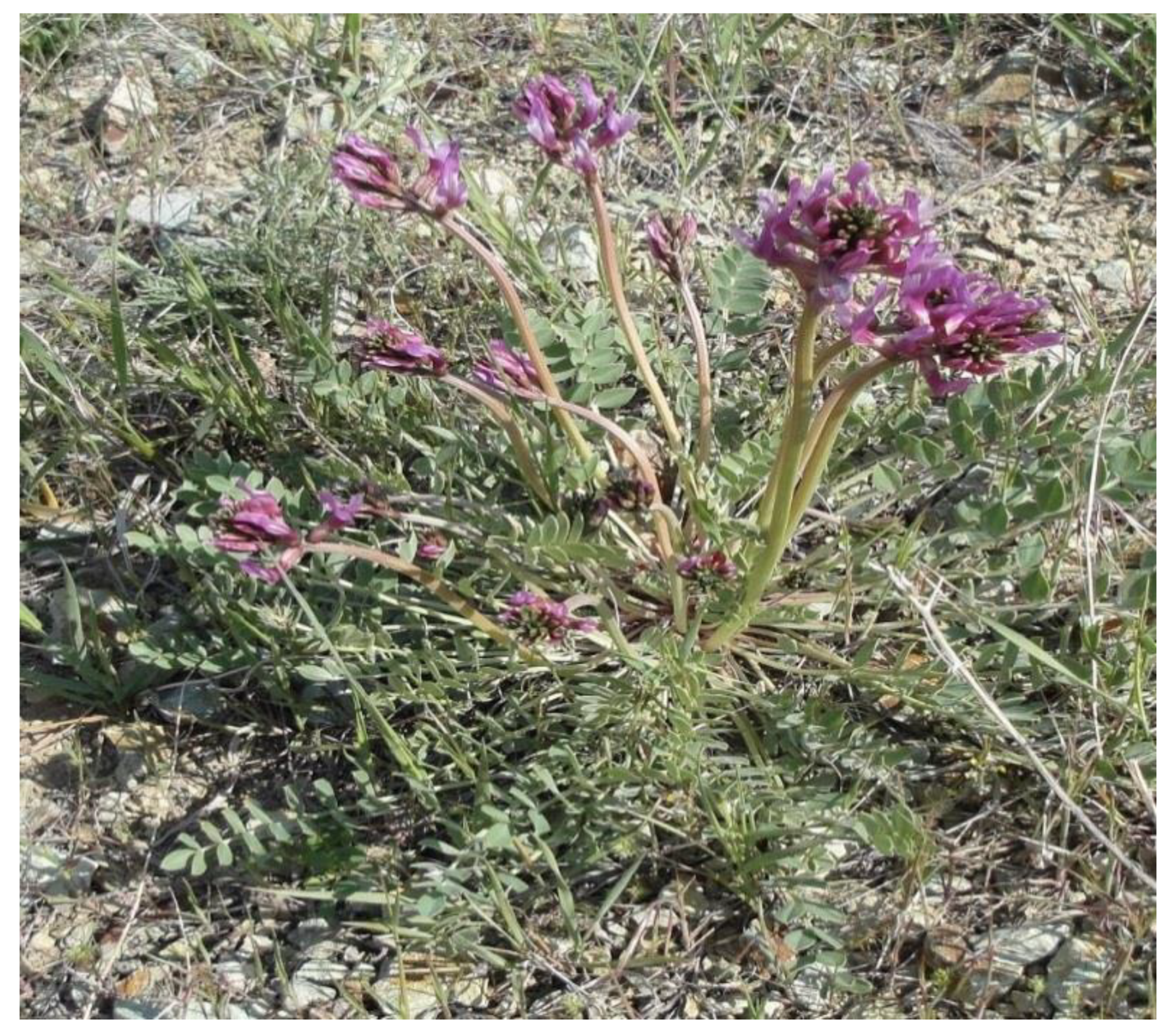

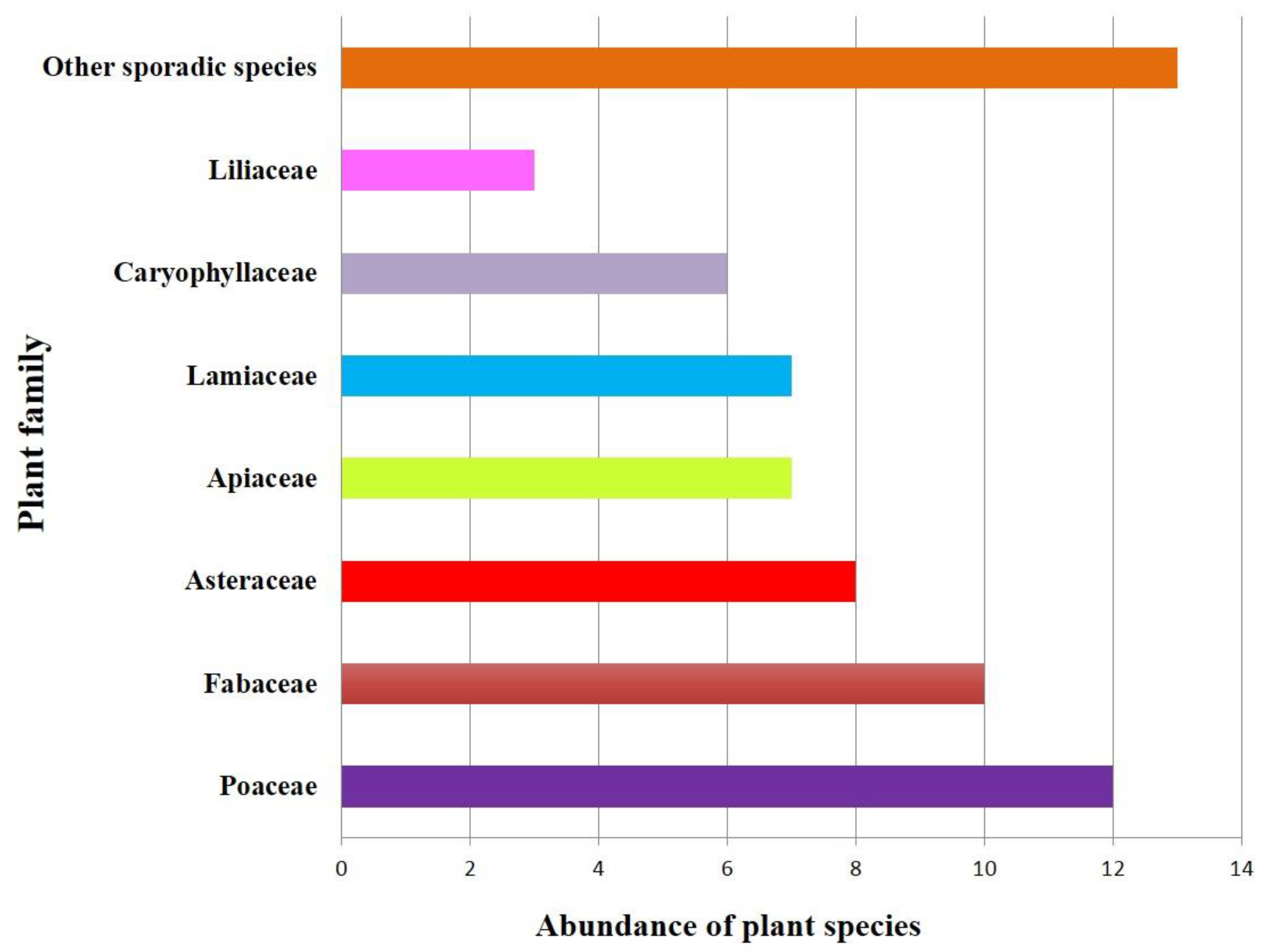



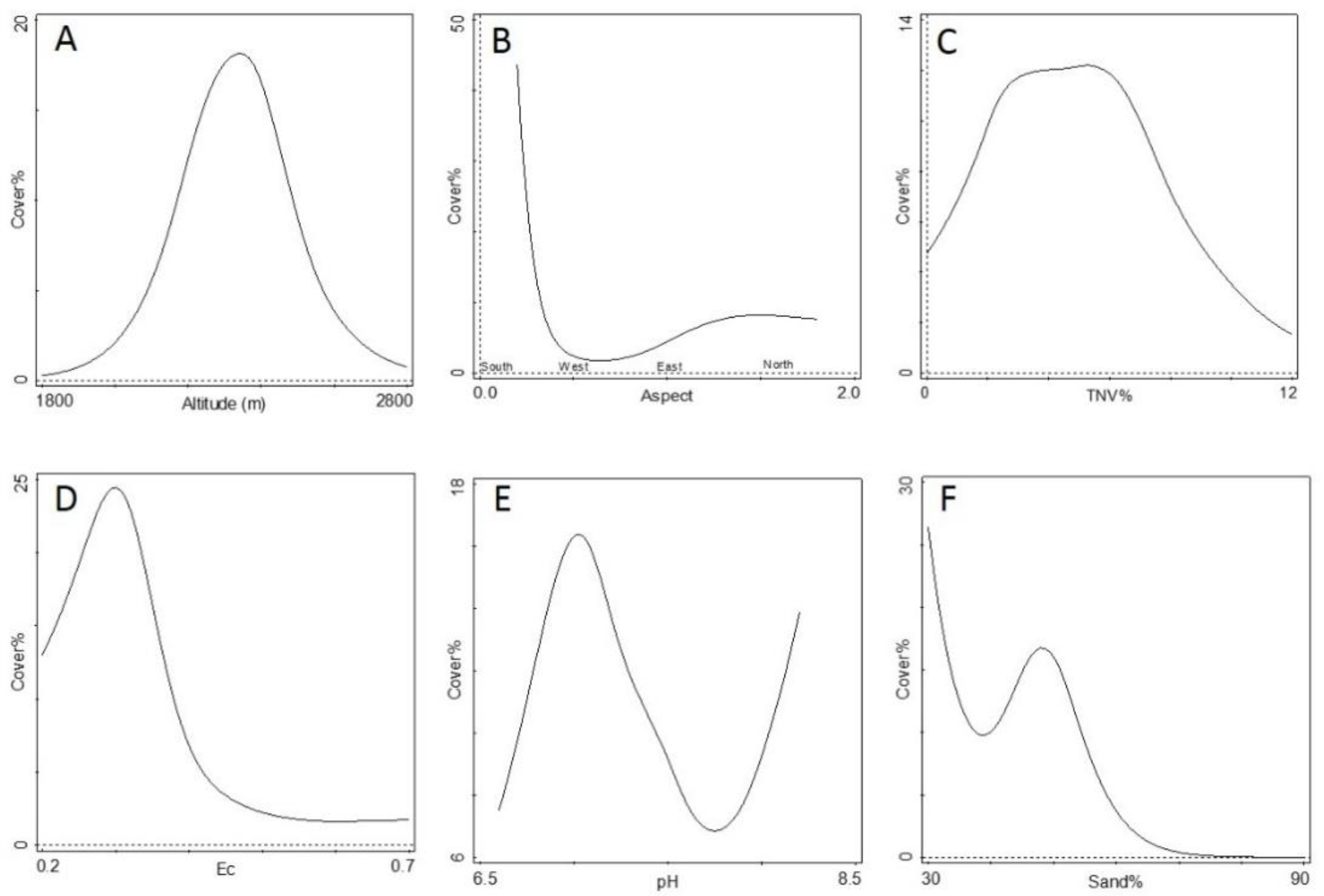

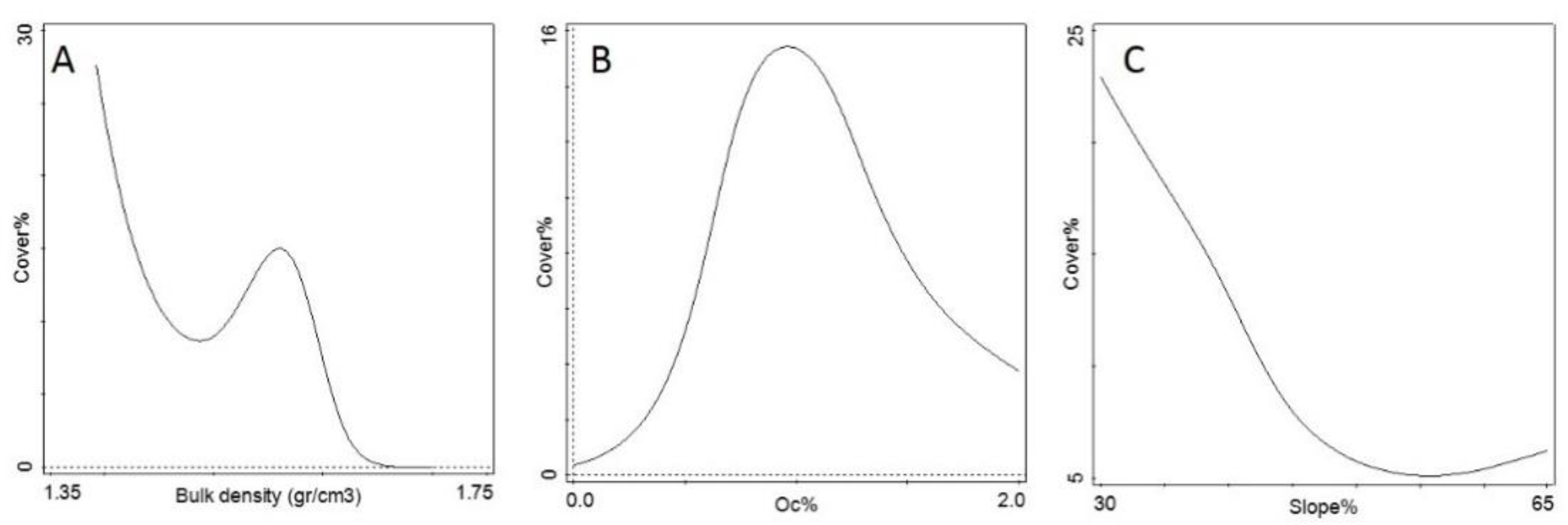
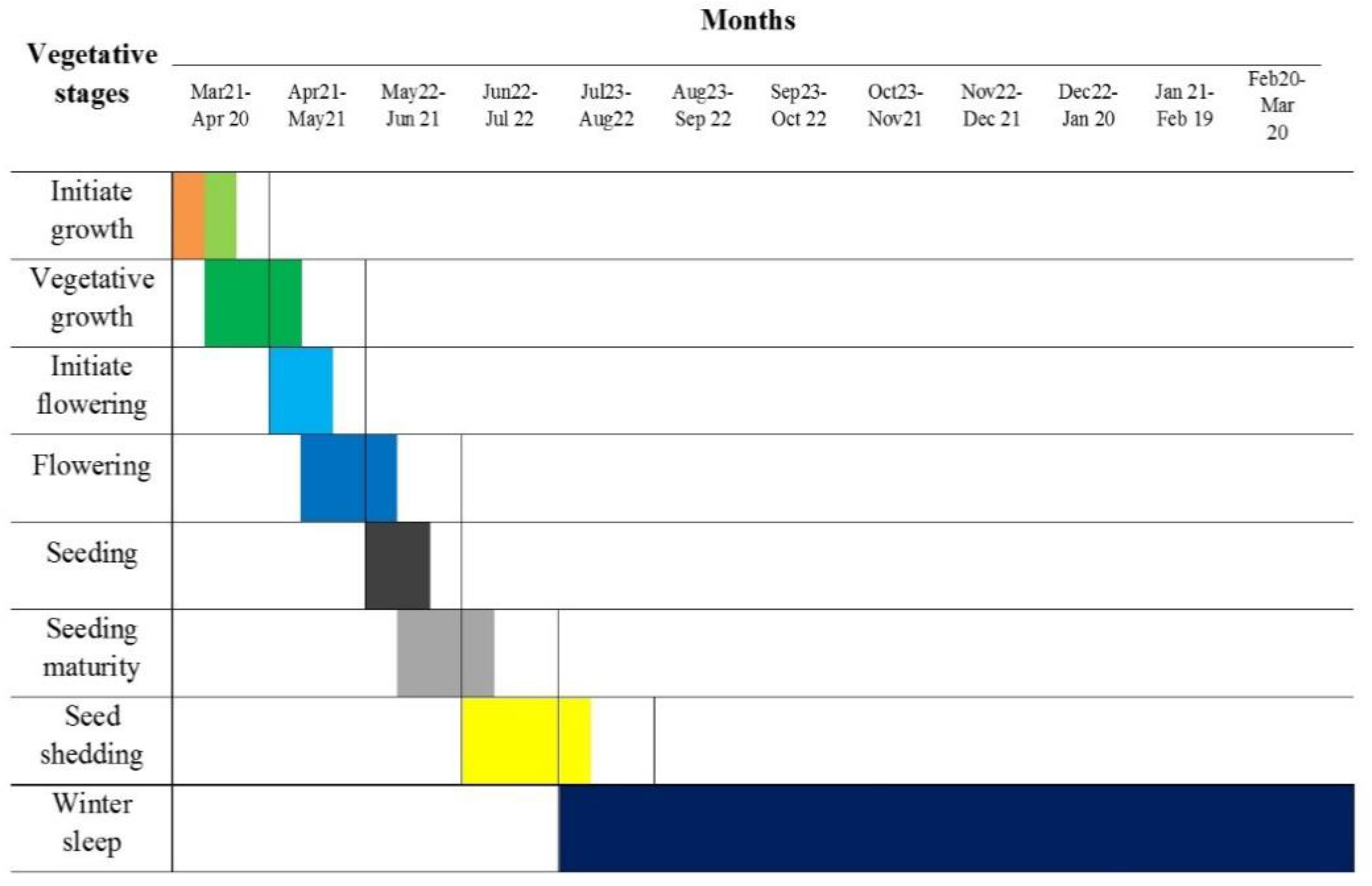
| Forage Production of Target Species (kg/ha) | Frequency of Target Species (%) | Density of Target Species (Ha) | Canopy Cover of Target Species (%) | Gravel and Stones on the Soil Surface (%) | Bare Soil (%) | Litter (%) | Total of Canopy Cover (%) |
|---|---|---|---|---|---|---|---|
| 198 | 67 | 41,667 | 10 | 23 | 18 | 3.9 | 54.9 |
| Environmental Variables | F | P | AIC |
|---|---|---|---|
| OC (%) | 3.03 | 0.05 | 390.3 |
| SP (%) | 13.78 | 0 | 212.22 |
| EC (ds/m) | 10.74 | 0 | 248.49 |
| pH | 10.9 | 0 | 376.35 |
| TNV (%) | 11.4 | 0 | 374.87 |
| BD (gr/cm3) | 6.08 | 0 | 323 |
| Cl (%) | 8.05 | 0 | 273.87 |
| Sa (%) | 10.1 | 0 | 254.15 |
| Si (%) | 11.65 | 0 | 244.32 |
| BS (%) | 11.99 | 0 | 227.7 |
| St (%) | 5.32 | 0 | 333.42 |
| Li (%) | 3.74 | 0.02 | 367.13 |
| Sl (%) | 3.29 | 0.04 | 383.22 |
| Al (m) | 4.96 | 0 | 339.38 |
| As (d) | 23.8 | 0 | 336.82 |
Publisher’s Note: MDPI stays neutral with regard to jurisdictional claims in published maps and institutional affiliations. |
© 2021 by the authors. Licensee MDPI, Basel, Switzerland. This article is an open access article distributed under the terms and conditions of the Creative Commons Attribution (CC BY) license (https://creativecommons.org/licenses/by/4.0/).
Share and Cite
Aghajanlou, F.; Mirdavoudi, H.; Shojaee, M.; Mac Sweeney, E.; Mastinu, A.; Moradi, P. Rangeland Management and Ecological Adaptation Analysis Model for Astragalus curvirostris Boiss. Horticulturae 2021, 7, 67. https://doi.org/10.3390/horticulturae7040067
Aghajanlou F, Mirdavoudi H, Shojaee M, Mac Sweeney E, Mastinu A, Moradi P. Rangeland Management and Ecological Adaptation Analysis Model for Astragalus curvirostris Boiss. Horticulturae. 2021; 7(4):67. https://doi.org/10.3390/horticulturae7040067
Chicago/Turabian StyleAghajanlou, Farhad, Hamidreza Mirdavoudi, Mohammad Shojaee, Eileen Mac Sweeney, Andrea Mastinu, and Parviz Moradi. 2021. "Rangeland Management and Ecological Adaptation Analysis Model for Astragalus curvirostris Boiss" Horticulturae 7, no. 4: 67. https://doi.org/10.3390/horticulturae7040067
APA StyleAghajanlou, F., Mirdavoudi, H., Shojaee, M., Mac Sweeney, E., Mastinu, A., & Moradi, P. (2021). Rangeland Management and Ecological Adaptation Analysis Model for Astragalus curvirostris Boiss. Horticulturae, 7(4), 67. https://doi.org/10.3390/horticulturae7040067







